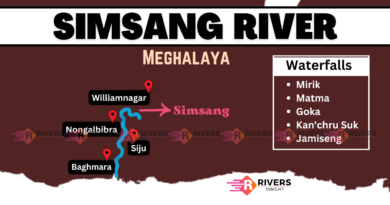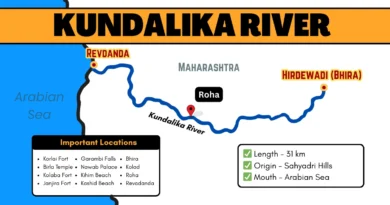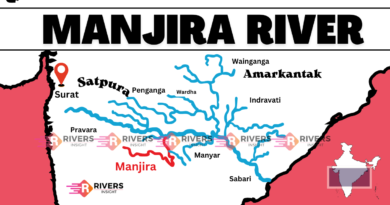Vamsadhara River: Map, Origin, and Tributaries
The Vamsadhara River derives its name from the combination of ‘bansa,’ meaning bamboo, and ‘dhara,’ meaning water flow. Originating from bamboo-covered forests, the river was originally named Bansadhara in Oriya, which was later transliterated as Vamsadhara in Telugu.
| Feature | Details |
|---|---|
| Also Known As | Bansadhara (in Odisha) |
| River Type | East-flowing, Peninsular River |
| Origin | Odisha |
| Length | Approximately 254 km |
| Confluence (Mouth) | Bay of Bengal, at Kalingapatnam, Andhra Pradesh |
| Basin Area | ~10,830 sq km |
| Tributaries or Distributary | Sananadi, Mahendratanaya |
| States Covered | Odisha and Andhra Pradesh |
Table of Contents
Geographical Features of Vamsadhara River
The Vamsadhara River, also known as Bansadhara in Odisha, is a prominent east-flowing river situated between the Godavari and Mahanadi rivers in India. Here are its key geographical features:
Origin and Flow
The river originates from the border region of Kalyansinghpur in Rayagada district and Thuamul Rampur in Kalahandi district, Odisha. It travels a total length of 254 kilometres before emptying into the Bay of Bengal at Kalingapatnam in Andhra Pradesh.
River Basin
The Vamsadhara River’s catchment area spans approximately 10,830 square kilometres. This area includes diverse landscapes, ranging from hilly terrains to agricultural plains, influencing the river’s flow and characteristics.
- 8,015 square kilometres in Odisha
- 2,815 square kilometres in Andhra Pradesh
Tributary of Vamsadhara River
One of the significant tributaries of the Vamsadhara River is the Mahendratanaya, originating in Gajapati district, Odisha. This tributary joins the main river in Andhra Pradesh, upstream of the Gotta Barrage. In efforts to divert water for irrigation, construction has commenced on the Regulapadu Barrage.
Water Sharing and Irrigation Projects
With an estimated water yield of approximately 115 thousand million cubic feet, both Odisha and Andhra Pradesh share the river’s resources under a 50:50 agreement. Significant irrigation projects like the Neredi Barrage and Gotta Barrage in Andhra Pradesh aim to harness the river’s water for agricultural purposes.




